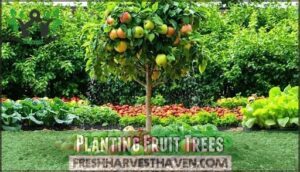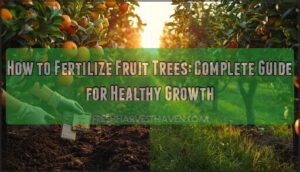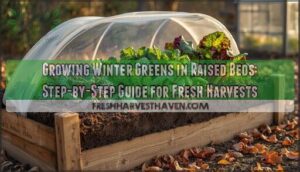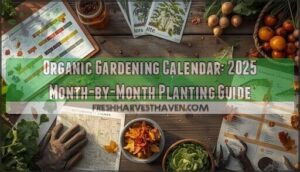This site is supported by our readers. We may earn a commission, at no cost to you, if you purchase through links.
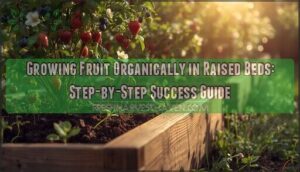
Opt for untreated cedar beds, about four feet wide and deep enough for roots to stretch, giving your trees both room and resilience.
Remember, pollination matters: mix self-pollinating types or bring buddies for cross-pollination.
Harness the power of bees and companion herbs to outsmart pests, and pick cold-hardy cultivars if winter likes to bite.
Raised beds warm up quickly, making you spring’s early bird.
The real secret? Sharpen your eye for soil quality—your fruit’s flavor depends on it.
Table Of Contents
- Key Takeaways
- Selecting Fruit Trees
- Raised Bed Design
- Site Selection Tips
- Preparing Raised Bed Soil
- Planting Fruit Trees
- Ongoing Fruit Tree Care
- Common Raised Bed Challenges
- Maximizing Raised Bed Yield
- Frequently Asked Questions (FAQs)
- Can you grow fruits in raised beds?
- What is organic raised bed soil?
- How to start an organic raised garden bed?
- Can you grow large fruits & vegetables in a raised garden?
- How do you grow a tree in a raised bed?
- How do I match my raised bed to my Fruit Tree?
- What fruit grows best in raised beds?
- What vegetables should not be grown in a raised bed?
- How to make your own organic raised bed soil?
- Can you grow fruit trees in a raised bed?
- Conclusion
Key Takeaways
- Pick dwarf fruit tree varieties for raised beds—they save space, produce full harvests, and start fruiting sooner.
- Always use untreated, rot-resistant wood like cedar and make sure your beds are deep and wide enough for healthy root systems.
- Mix self-pollinating and cross-pollinating trees, plant companion herbs, and attract bees to maximize fruit set and keep pests in check.
- Focus on soil quality: blend compost, garden soil, and aerators, and test pH to support strong yields and resilient growth.
Selecting Fruit Trees
Choosing the right fruit trees for your raised beds sets the foundation for years of organic harvests.
You’ll need to examine three key factors: selecting dwarf varieties that won’t outgrow your space, understanding pollination requirements to guarantee fruit production, and choosing cold-hardy options that can survive your local winters.
Dwarf Varieties
When growing organic fruit in raised beds, dwarf varieties become your best allies for maximizing productivity in minimal space.
Dwarf fruit trees deliver full harvests in tight spaces, making every square foot of your raised bed count
These compact trees reach only 8-12 feet at maturity, making them perfect for raised bed gardening.
You’ll harvest full-sized fruit from trees that won’t overwhelm your garden space.
Dwarf roots create efficient growing systems that thrive in controlled environments.
Plant breeding has produced cultivars that maintain excellent fruit size while keeping tree height manageable.
Your crop yield remains impressive despite the smaller plant footprint.
- Early harvests – Fruit production begins within 2-3 years versus 5-7 years for standard trees
- Space efficiency – Plant multiple dwarf fruit trees in the same area a single standard tree would occupy
- Simplified maintenance – Pruning, pest control, and harvesting stay within comfortable reach
These dwarf varieties excel in raised bed conditions where their confined root systems actually prefer the controlled soil environment you’ll create.
For ideal growth, consider dwarf fruit tree characteristics when selecting varieties.
Pollination Requirements
After selecting the right dwarf varieties, you’ll need to understand pollination needs to avoid empty branches come harvest time.
Most fruit trees require cross pollination partners within fifty feet, demanding compatible varieties with synchronized blooming periods.
Self-pollinating options like certain peaches eliminate partner requirements, perfect for limited raised bed space.
Bee pollination drives most fruit set, so plant pollinator-friendly plants like lavender nearby to boost flower attraction.
When weather disrupts natural pollen transfer, hand pollination saves your crop.
| Tree Type | Pollination Need | Compatible Partners |
|---|---|---|
| Apple | Cross pollination | Honeycrisp + Gala |
| Cherry | Cross pollination | Bing + Stella |
| Peach | Self-pollinating | None required |
Companion planting with herbs supports beneficial insects while managing pest populations naturally.
Cold Hardy Options
Winter’s harsh bite doesn’t have to spell doom for your fruit dreams. After considering pollination needs, you’ll want hardy varieties that laugh in the face of freezing temperatures and thrive in your raised bed construction.
Cold hardiness determines whether your dwarf fruit trees survive brutal winters while still producing abundant harvests. Your organic raised bed soil warms faster than ground-level plantings, giving roots vital frost protection during temperature swings.
Smart fruit selection means choosing varieties rated two zones colder than your location. Most hardy varieties require 800-1,200 chill hours below 45°F for proper dormancy and spring flowering.
Winter warriors that’ll make you smile:
- Honeycrisp apples surviving bone-chilling -30°F temperatures
- North Star cherries producing sweet rewards after harsh winters
- Prairie Magic apples thriving where others fail
- Evans Bali cherries defying brutal Canadian cold
Your raised bed’s microclimate advantage means earlier spring warmth and better winter care, turning fruit tree care into a year-round success story.
Raised Bed Design
You’ll need to choose durable, non-toxic materials and size your raised beds to support healthy root development.
Effective drainage systems keep your fruit trees’ roots safe from waterlogging and soil contamination.
Wood Selection
Once you’ve picked your fruit trees, it’s time to think about wood selection for your raised bed frames. Choosing the right material means your beds stay sturdy, safe, and chemical-free for years.
Cedar options top the list—untreated cedar’s natural rot resistance gives you 10-15 years of Wood Durability without worrying about toxins. If you’re after Sustainable Timber, FSC-certified hardwood lumber like white oak or cypress is a solid bet.
For those who prefer low maintenance, Composite Materials made from recycled plastic can last 25+ years. Pine is a budget choice, though you’ll be swapping out frames every few seasons.
Here’s a quick breakdown:
- Untreated cedar—rot resistance, chemical-free
- FSC-certified hardwoods—long-lasting, eco-friendly
- Composite materials—maximum durability
- Pine—affordable, short lifespan
When building raised beds, consider using cedar raised beds for their natural durability and resistance to rot.
Bed Size Considerations
When planning your raised bed gardening project, getting the bed size right is key to healthy fruit trees. Aim for a bed width of 4 feet for easy reach, and a Bed Depth of 18–24 inches to support robust Root Space and Soil Volume.
Use the table below to match Bed Width to tree type—no crowding, no stunted growth. Bed size directly affects Plant Density, so keep mature tree spread in mind.
Raised garden beds sized for your trees’ needs make maintenance a breeze and boost organic raised bed soil health. Don’t let cramped quarters limit your orchard dreams—space wisely!
Proper soil quality checks are essential for ideal tree growth.
Drainage Systems
In terms of keeping your fruit trees’ roots happy, proper drainage systems are your best insurance policy.
Overly soggy soil suffocates roots, but well-draining soil lets them breathe easy.
Boost soil permeability and control water tables with these essentials:
- Gravel layers at the bed base improve water movement by 50%.
- Drain pipes for beds deeper than 12 inches prevent waterlogging and root rot.
- Drip irrigation systems deliver steady moisture, avoiding oversaturation.
Choose clean, angular gravel for best results.
With smart raised bed irrigation and drainage systems, you’ll keep your orchard thriving—no soggy surprises.
Site Selection Tips
You’ll want to pick a spot with full sun, well-drained soil, and shelter from strong winds to give your fruit the best start.
Choosing the right location helps prevent stunted growth and protects your investment from unpredictable weather.
Sunlight Requirements
After sorting out your raised bed design, it’s time to talk sunlight—the fuel for fruit. Fruit trees thrive on six to eight daily hours of full sun, so picking a sunny spot is non-negotiable.
Morning sun gives your trees a jumpstart, powering photosynthesis when they need it most. Full shade or even partial sun can cut your harvest in half, leaving you with more leaves than fruit.
Don’t let a southfacing garden fool you; sun orientation changes with the seasons, so map sun exposure for each month. Watch how shadows from buildings or trees creep across your beds—those shady patches can stunt growth and fruiting.
Here’s how to nail it:
- Track sun patterns year-round to find consistent light.
- Position beds facing south or southwest for maximum sun orientation.
- Avoid morning shadow zones that rob your trees of energy.
Soil Conditions
Think of your raised bed soil as a chef’s secret sauce—get the mix right for thriving fruit.
A rich soil blend is the secret recipe that transforms ordinary beds into extraordinary fruit gardens
Aim for soil pH between 6.0 and 7.5 to keep nutrient balance in check.
Blend 60% garden soil, 30% compost, and 10% perlite for a nutrient-rich, well-draining soil structure.
Regular soil testing lets you fine-tune amendments, boosting soil quality and organic matter.
Compost tea supercharges microbial life, creating a lively, healthy bed for your fruit trees, which is essential for a thriving fruit production.
Wind Protection
In the context of wind protection in raised bed gardening, don’t let gusts play havoc with your organic fruit gardening dreams.
Smart placement of Wind Breaks and Barrier Fencing shields your fruit trees, reducing Soil Erosion and boosting Frost Protection.
Try these strategies:
- Plant dense evergreen hedgerows 10-15 feet upwind for up to 70% wind reduction
- Use Tree Guards or temporary burlap screens while young trees establish
Strategic fruit tree care means positioning raised garden beds near natural or built barriers, letting your harvest flourish.
Preparing Raised Bed Soil
You’ll want to start with a balanced mix of garden soil, compost, and aeration materials to support healthy root growth.
Testing pH and blending in organic amendments guarantees your fruit crops get the nutrients they need for strong yields.
Organic Amendments
How do you turn basic dirt into a powerhouse for fruit trees? You start with organic amendments.
Compost Tea isn’t just a buzzword—it boosts microbial activity by up to 200%, helping roots grab nutrients fast.
Manure Fertilizer, especially well-aged, feeds your fruit plants steady nitrogen without scorching roots.
Soil Conditioners like biochar and rock dust improve drainage and add trace minerals you won’t get from synthetic options.
OMRI-certified amendments mean you’re sticking to safe, organic fertilizer methods.
Don’t forget to test soil pH—most fruit crops thrive between 6.0 and 6.8.
Natural Mulch keeps moisture in and weeds out, while regular top-dressing with organic amendments keeps your organic soil mix lively.
Composting for gardens isn’t just a chore; it’s the secret sauce for robust fruit production and resilient, healthy raised beds.
Using effective compost tea methods can substantially enhance soil fertility and structure.
Compost Mixing
After you’ve chosen your organic amendments, it’s time to master compost mixing. Aim for a Carbon Ratio of 30:1—layer dried leaves with kitchen scraps for a nutrient-rich blend.
Weekly turning boosts Microbe Balance and keeps that microbial activity humming. Monitor temperatures; a pile hitting 130-160°F is breaking down fast.
Finished compost should smell earthy and crumble easily. Mix it into your organic soil mix for improved Soil Blending. Chop materials small for quicker results.
Compost Tea adds another kick for composting for gardens.
- Imagine a steaming compost pile, alive with microbes, transforming waste into black gold.
Planting Fruit Trees
You’ll need to prepare a planting hole that accommodates the root system and guarantees proper drainage, so your tree establishes quickly.
Pay attention to root spread and water thoroughly, because fruit trees don’t appreciate dry starts or cramped quarters.
Hole Preparation
Precision matters in hole preparation—don’t let haste spoil your raised bed gardening dreams.
For each fruit tree, dig a hole with a Soil Depth that matches your Root Ball height exactly, while the Hole Size should be twice as wide as the root ball’s diameter.
This guarantees roots have room to spread and settle without stress.
Test drainage by filling the hole with water; if it vanishes within 24 hours, you’re golden.
Loosen the edges so roots don’t hit a brick wall, but avoid creating air pockets that sabotage stability.
Backfill with soil that’s level with the surrounding Bed Layout for seamless Plant Placement.
Following these organic gardening methods sets the stage for healthy growth and keeps soil quality and drainage systems in check.
Root Spread
Lifting your tree from its pot, take a moment to untangle any roots circling the root ball—that twisty mess can strangle future growth like a strangled garden hose.
Fan the roots out horizontally across the organic raised bed soil, hitting ideal root depth and maximizing soil volume for robust nutrient uptake.
Position your root ball at the same height as the surrounding raised bed—this guarantees drainage runs like clockwork.
Clip away any damaged roots with clean pruners before planting to prevent soil compaction.
Drop the stakes—proper root spread and tree spacing create natural stability.
With mature root spread, your tree taps every inch of bed capacity and plant density, finding the freedom it needs for lush, healthy growth.
Proper container selection involves considering disease resistant varieties to guarantee the tree’s overall health.
This approach also encourages balanced Tree Spacing, promotes even Plant Density, and maximizes Soil Quality for strong roots.
- Encourages balanced Tree Spacing
- Promotes even Plant Density
- Maximizes Soil Quality for strong roots
Watering Techniques
Give your fruit trees in raised beds the best start by perfecting your watering techniques.
Deep watering methods, like slow, steady soaks reaching twelve inches down, help roots stretch deep, staying hydrated and healthy. Drip irrigation shines for water conservation and delivers moisture precisely where it’s needed, cutting back on waste.
Want chemical-free hydration? Try rainwater harvesting and let nature chip in. For younger trees, hand watering provides the control you need to target fragile roots.
Keep an eye on soil moisture—reach two inches down, and if it feels like a wrung-out sponge, you’re golden. Mulching around your trees boosts water accessibility, retaining moisture like a trusty safety net.
Pick the right approach and watch consistent watering reward you with thriving, stress-free trees.
| Watering Method | Best Application | Key Advantage |
|---|---|---|
| Drip irrigation | Established trees | Water conservation |
| Soaker hoses | Large raised beds | Even distribution |
| Hand watering | Young saplings | Precise control |
| Rainwater collection | All fruit trees | Chemical-free water |
| Deep watering schedule | Weekly maintenance | Root development |
Ongoing Fruit Tree Care
You’ll need to monitor soil moisture, fertilize when necessary, and prune to manage canopy structure. Apply organic pest control methods regularly to keep your fruit trees healthy and productive.
Fertilization Schedules
Planting your fruit tree is just the start—keeping it healthy means nailing your fertilization schedules.
Use slow-release fertilizer and organic amendments for even nutrient cycling.
Here’s your playbook:
- Early spring: Apply organic fertilizers when soil hits 55°F.
- Bud break: Side-dress with compost and blood meal.
- Summer: Bone meal every 4–6 weeks through July.
- Year-round: Run soil testing twice a year.
- Stay alert for nutrient deficiencies.
- Stop all feeds by late July for natural dormancy prep to ensure a healthy tree through natural dormancy.
Pruning Methods
How do you keep your fruit trees neat and loaded with fruit? Start with the right pruning tools and use sharp, clean blades with every cut.
Tackle Winter Cutting for structure by shaping young branches, then switch to Summer Pruning to control height and boost airflow.
Use Root Pruning and Fruit Thinning to prevent weak, overloaded branches—space fruit about 4–6 inches apart. Espalier training works wonders for tight spaces.
Sanitize your tools before pruning to stop disease spread. Skip the wound sealer; clean cuts heal better in organic gardening techniques.
Pest Management
When pests pop up, don’t let them run the show. Winning at organic pest control means mixing a bit of science with hands-on care.
Get ahead using Crop Barriers, monitor with Pest Traps, and treat with Organic Pesticides and Natural Repellents like neem oil. Beneficial Insects—think ladybugs and parasitic wasps—are your secret weapon for natural pest control.
Follow these three steps for integrated pest management:
- Prevent with sanitation and disease-resistant trees.
- Monitor using sticky traps.
- Treat only as needed.
Effective pest control also involves understanding safe pest control methods to minimize harm to the environment.
Common Raised Bed Challenges
You’ll encounter some specific challenges with raised beds, including pest invasions, rapid nutrient loss, and diseases creeping in from nearby soil.
Managing these issues requires careful monitoring, timely intervention, and a solid grasp of organic solutions.
Pest Control Methods
Healthy fruit trees need more than water and sunshine—guard them with smart, natural pest control.
Beneficial Insects are your tiny bodyguards, keeping harmful bugs in check.
Use Pest Barriers like row covers; they’re an old favorite, blocking 70% of crawling invaders.
For flying pests, try yellow sticky traps and trap cropping to outsmart beetles.
When things get sticky, Organic Pesticides such as neem oil deliver targeted hits.
Combining these pest control methods—also called integrated pest management—protects your harvest without harming soil health.
Effective organic pest control methods involve using organic pest solutions to maintain a balanced ecosystem.
Disease Prevention
Don’t let your garden turn into a petri dish—disease prevention is all about the right moves at the right time.
For raised beds, use these proven tactics to stop outbreaks before they start:
- Remove every bit of leaf litter—pathogens love leftover mess
- Disinfect pruning tools to halt bacterial spread
- Water at the base to leave leaves dry and happy
- Space fruit trees for serious airflow, boosting fungal control
- Apply organic sprays like copper during dormancy for extra insurance
Clean habits and integrated pest management are your bedrock, essential for maintaining a healthy garden through proper care.
Nutrient Deficiencies
A hidden thief in your garden, nutrient deficiencies can quietly sabotage your fruit trees unless you know what to watch for.
Soil Testing gives you the upper hand, revealing imbalances before Deficiency Symptoms take hold.
Stay alert for these classic clues, and act fast with organic soil amendments and nutrient-rich solutions for healthy Nutrient Cycling.
- Yellowing leaves? That’s nitrogen missing in action, calling for a boost in your fertilization schedule.
- Stunted growth often means not enough phosphorus, limiting your tree’s progress.
- Brown leaf edges flag a potassium shortage, cutting into fruit quality.
- Pale foliage points to iron deficiency, common in alkaline beds lacking essential Micronutrients.
- Poor flowering may signal boron is getting left behind.
Maximizing Raised Bed Yield
You can boost your fruit harvest in raised beds by combining proven techniques—think companion planting, crop rotation, and vertical gardening.
With careful planning, you’ll make the most of every square foot while promoting healthy, productive plants, using techniques like crop rotation to ensure a bountiful harvest.
Companion Planting
Bring your raised beds to life using companion planting.
Surround fruit trees with Plant Partners like marigolds, nasturtiums, garlic, and chives—they attract beneficial insects, repel pests naturally, and boost soil health.
Embrace crop diversity to improve yield and nurture mutual benefits.
It’s organic gardening in action: organic amendments, natural fertilizer methods, and organic pest control—all working in harmony.
Crop Rotation
After pairing crops together, it’s time to outsmart pests and promote Soil Renewal with crop rotation. Think of raised bed farming as a long game—mix up your Plant Diversity and give the organic soil a fresh start each year.
To keep Seasonal Cycles working in your favor, plan your planting sequence this way:
- Grow heavy feeders, like fruit trees, first.
- Follow with light feeders—think fast-growing herbs and leafy greens.
- Finish with soil builders such as legumes for nitrogen boost.
Smart Crop Planning yields healthier soil and better Harvest Scheduling.
Vertical Gardening Techniques
After rotating crops through your raised garden beds, it’s time to look up—literally.
Trellis systems and Garden Towers put vertical gardening techniques into practice, turning square footage into a productive skyward climb.
You’ll train berry vines or dwarf fruit trees along sturdy supports or shape them into Living Walls, turning walls into Space Savers that double your harvest.
Wall Gardens aren’t just pretty—they help keep air moving, cutting down fungal issues notorious in organic gardening methods.
Hanging baskets overflow with strawberries, while tiered planters give blueberry bushes a spotlight at every level.
These approaches use less ground, making raised bed farming more efficient and helping you garden without chemicals and with more control.
Frequently Asked Questions (FAQs)
Can you grow fruits in raised beds?
Like building a home for your roots, you can grow fruits in raised beds by controlling soil quality and drainage.
Just make certain proper bed height, sun exposure, and spacing, and expect healthier plants with fewer pests and diseases.
What is organic raised bed soil?
Organic raised bed soil is a mix of clean garden soil, compost, and aerators like perlite.
You’ll avoid synthetic fertilizers, sticking with natural amendments for nutrients.
Keep it well-draining and rich, and watch your plants thrive.
How to start an organic raised garden bed?
Worried about hard work?
Just build a 4×8 foot untreated cedar frame, fill it with rich compost and aerated soil.
Check pH, and plant—nature will handle the rest if you water and mulch well.
Can you grow large fruits & vegetables in a raised garden?
You absolutely can grow large fruits and vegetables in a raised garden—just build deep, wide beds with rich organic soil, and make sure they get plenty of sun and water.
Even melons and squash can thrive this way.
How do you grow a tree in a raised bed?
Of course, planting a tree in a raised bed is just what trees dream about—roots craving room!
Give it at least 18 inches of deep, rich soil, water consistently, and make certain root flare stays above soil for healthy growth.
How do I match my raised bed to my Fruit Tree?
Pick a raised bed that matches your tree’s mature root depth and canopy width.
Go for beds at least 18–24 inches deep, 4 feet wide, with room for easy access.
Roots need space, drainage, and breathing room.
What fruit grows best in raised beds?
Back in the Stone Age, you’d be berry-hunting; now, strawberries, blueberries, and raspberries thrive in raised beds thanks to better drainage and root control.
Dwarf fruit trees also excel, staying manageable and producing fruit within two to three years, which is a key factor in their success due to better drainage and root control.
What vegetables should not be grown in a raised bed?
Don’t plant corn, pumpkins, or sprawling squash in raised beds—they hog space and shade neighbors.
Deep-rooted asparagus or artichokes also struggle, often outgrowing limited depth.
Stick to crops that thrive in shallow, contained environments for better yields, focusing on those that do well in such conditions, like crops.
How to make your own organic raised bed soil?
Building soil from scratch is like crafting a recipe—mix 60% clean garden soil, 30% rich compost, and 10% perlite.
Test pH, verify drainage, and amend with OMRI-certified organic nutrients for robust, resilient plant roots.
Can you grow fruit trees in a raised bed?
You absolutely can grow fruit trees in a raised bed.
Just be sure the bed’s deep enough for roots and wide enough for support.
Choose compact or dwarf trees—standard-sized trees will quickly outgrow their space and topple your apple cart.
Conclusion
Let your raised beds become the launch pad for growing fruit organically in raised beds, setting your orchard up for resilience and yield.
You’ve got the DNA for success—careful variety choice, tight soil science, and smart design.
With the right pollinators and vigilant care, every square foot can thrive.
Monitor water, nutrients, and pests, and don’t forget to rotate companion plants.
Soon, you’ll harvest not just fruit, but the sweet rewards of technical know-how.
- https://www.ollegardens.com/blogs/news/knowledge-from-garden-beds-10-fruits-to-grow-in-raised-beds
- https://www.woodblocx.co.uk/blog/what-to-grow-in-raised-beds/
- https://www.youtube.com/watch?v=uCM0Tvp6Dko
- https://www.epicgardening.com/fruit-trees-raised-beds/
- https://fruittreehub.com/can-i-plant-fruit-trees-in-a-raised-bed/


